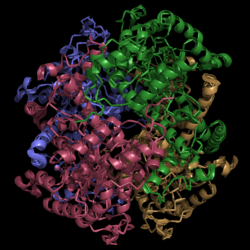Sandbox Reserved 1058
From Proteopedia
(Difference between revisions)
| Line 6: | Line 6: | ||
===Clinical Implications=== | ===Clinical Implications=== | ||
Isocitrate lyase plays a key role in survival of ''M. tuberculosis'' by sustaining intracellular infections in inflammatory respiratory macrophages. Used in the citric acid cycle, isocitrate lyase is the first enzyme catalyzing the carbon conserving glyoxylate pathway. This glyoxylate pathway has not been observed in mammals and thus presents a unique drug target to solely attack TB infections. | Isocitrate lyase plays a key role in survival of ''M. tuberculosis'' by sustaining intracellular infections in inflammatory respiratory macrophages. Used in the citric acid cycle, isocitrate lyase is the first enzyme catalyzing the carbon conserving glyoxylate pathway. This glyoxylate pathway has not been observed in mammals and thus presents a unique drug target to solely attack TB infections. | ||
| + | ===Mechanism of Action=== | ||
| + | |||
==Protein Structure== | ==Protein Structure== | ||
===Crystal Structure=== | ===Crystal Structure=== | ||
[[Image:Normal_Crystal_Structure.png|250 px|center|thumb|'''Figure 1. Structure of Isocitrate Lyase.''' Quaternary structure is comprised of four subunits forming an alpha/beta barrel.]] | [[Image:Normal_Crystal_Structure.png|250 px|center|thumb|'''Figure 1. Structure of Isocitrate Lyase.''' Quaternary structure is comprised of four subunits forming an alpha/beta barrel.]] | ||
| - | Isocitrate lyase is a tetramer with 222 symmetry. Each subunit is composed of 14 alpha helices and 14 beta sheets. A unique structural feature of this enzyme is a phenomenon called "helix swapping" '''GREEN BUTTON'''. | + | Isocitrate lyase (PDB Code 1F8I) is a tetramer with 222 symmetry. Each subunit is composed of 14 alpha helices and 14 beta sheets. A unique structural feature of this enzyme is a phenomenon called "helix swapping" '''GREEN BUTTON'''. |
| - | Helix swapping is observed between two monomers to form stable dimers. The 11th and 12th helices of each monomer exchange three dimensional placement with the respective helices of the opposite monomer '''GREEN BUTTON'''. Due to the 222 symmetry observed, only two dimers form than combine to form the observed tetramer. | + | Helix swapping is observed between two monomers to form stable dimers. The 11th and 12th helices of each monomer exchange three dimensional placement with the respective helices of the opposite monomer '''GREEN BUTTON'''. Due to the 222 symmetry observed, only two dimers form than combine to form the observed tetramer. As a result of this structure, 18% of the surface of each monomer is buried within the protein. |
| + | |||
| + | |||
== Function == | == Function == | ||
Revision as of 17:53, 27 March 2015
Isocitrate Lyase from Mycobacterium tuberculosis
| |||||||||||

